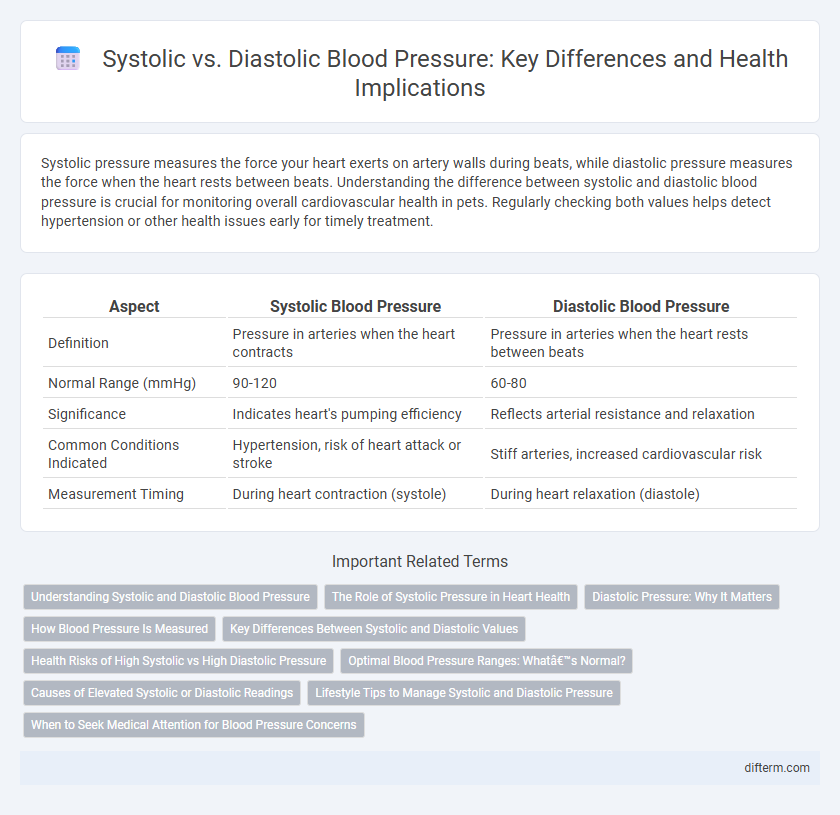Systolic pressure measures the force your heart exerts on artery walls during beats, while diastolic pressure measures the force when the heart rests between beats. Understanding the difference between systolic and diastolic blood pressure is crucial for monitoring overall cardiovascular health in pets. Regularly checking both values helps detect hypertension or other health issues early for timely treatment.
Table of Comparison
| Aspect | Systolic Blood Pressure | Diastolic Blood Pressure |
|---|---|---|
| Definition | Pressure in arteries when the heart contracts | Pressure in arteries when the heart rests between beats |
| Normal Range (mmHg) | 90-120 | 60-80 |
| Significance | Indicates heart's pumping efficiency | Reflects arterial resistance and relaxation |
| Common Conditions Indicated | Hypertension, risk of heart attack or stroke | Stiff arteries, increased cardiovascular risk |
| Measurement Timing | During heart contraction (systole) | During heart relaxation (diastole) |
Understanding Systolic and Diastolic Blood Pressure
Systolic blood pressure measures the force your heart exerts on artery walls during a heartbeat, typically recorded as the higher number. Diastolic blood pressure represents the pressure in your arteries when your heart rests between beats, noted as the lower number. Accurate interpretation of both readings is crucial for diagnosing hypertension and assessing cardiovascular health risks.
The Role of Systolic Pressure in Heart Health
Systolic pressure, the top number in a blood pressure reading, measures the force exerted on artery walls when the heart beats and pumps blood. Elevated systolic pressure indicates increased cardiovascular risk, including hypertension, heart attack, and stroke. Monitoring systolic blood pressure is crucial for early detection and management of heart-related conditions to maintain optimal cardiovascular health.
Diastolic Pressure: Why It Matters
Diastolic pressure measures the force exerted on artery walls between heartbeats, indicating the heart's resting state and vascular resistance. Elevated diastolic pressure, typically above 80 mmHg, increases the risk of heart disease, stroke, and kidney damage by straining blood vessels and the heart. Monitoring diastolic pressure alongside systolic readings provides a comprehensive assessment of cardiovascular health and guides effective treatment plans.
How Blood Pressure Is Measured
Blood pressure is measured using a sphygmomanometer, which records systolic and diastolic pressure in millimeters of mercury (mmHg). Systolic pressure reflects the force exerted on artery walls during heartbeats when the heart contracts, while diastolic pressure measures the pressure when the heart rests between beats. Accurate blood pressure readings depend on proper cuff placement and patient positioning to ensure reliable assessment for diagnosing hypertension or other cardiovascular conditions.
Key Differences Between Systolic and Diastolic Values
Systolic blood pressure measures the force exerted on artery walls during heartbeats, while diastolic pressure reflects the force between beats when the heart rests. A normal systolic reading is typically below 120 mmHg, whereas normal diastolic values are under 80 mmHg. Elevated systolic values often indicate cardiovascular strain, whereas high diastolic pressure may signal persistent arterial resistance.
Health Risks of High Systolic vs High Diastolic Pressure
High systolic pressure above 130 mmHg significantly increases the risk of cardiovascular diseases, including heart attacks and strokes, by putting extra strain on arteries and the heart. Elevated diastolic pressure over 80 mmHg also raises health risks but is more strongly associated with damage to smaller blood vessels and increased risk of heart failure and kidney disease. Managing both systolic and diastolic hypertension is crucial to reduce the likelihood of severe health complications and improve overall cardiovascular outcomes.
Optimal Blood Pressure Ranges: What’s Normal?
Optimal blood pressure ranges are typically defined as a systolic pressure between 90 and 120 mm Hg and a diastolic pressure between 60 and 80 mm Hg. Systolic pressure measures the force in arteries during heartbeats, while diastolic pressure reflects the force between beats when the heart rests. Maintaining blood pressure within these normal ranges reduces the risk of cardiovascular diseases and supports overall heart health.
Causes of Elevated Systolic or Diastolic Readings
Elevated systolic blood pressure often results from arterial stiffness, increasing with age or due to conditions like atherosclerosis and hyperthyroidism, while elevated diastolic pressure is frequently linked to factors such as obesity, kidney disease, and excessive salt intake. Chronic stress and hormonal imbalances, including adrenal gland disorders, can contribute to sustained high systolic or diastolic readings. Identifying underlying causes is crucial for targeted treatment and effective management of hypertension.
Lifestyle Tips to Manage Systolic and Diastolic Pressure
Maintaining a balanced diet rich in fruits, vegetables, and low-fat dairy products supports optimal systolic and diastolic blood pressure levels. Regular physical activity, such as brisk walking or cycling for at least 150 minutes per week, effectively lowers high blood pressure by strengthening heart function. Limiting sodium intake to under 2,300 milligrams daily helps prevent excessive pressure on artery walls, while stress management techniques like meditation and deep breathing promote healthier systolic and diastolic readings.
When to Seek Medical Attention for Blood Pressure Concerns
Seek medical attention immediately if systolic pressure exceeds 180 mm Hg or diastolic pressure rises above 120 mm Hg, as these readings indicate a hypertensive crisis requiring urgent care. Persistent systolic readings consistently above 140 mm Hg or diastolic pressure over 90 mm Hg also warrant consultation to prevent complications such as stroke or heart disease. Monitoring symptoms like severe headaches, chest pain, shortness of breath, or vision changes alongside high blood pressure readings is critical for timely intervention.
Systolic vs Diastolic Infographic

 difterm.com
difterm.com